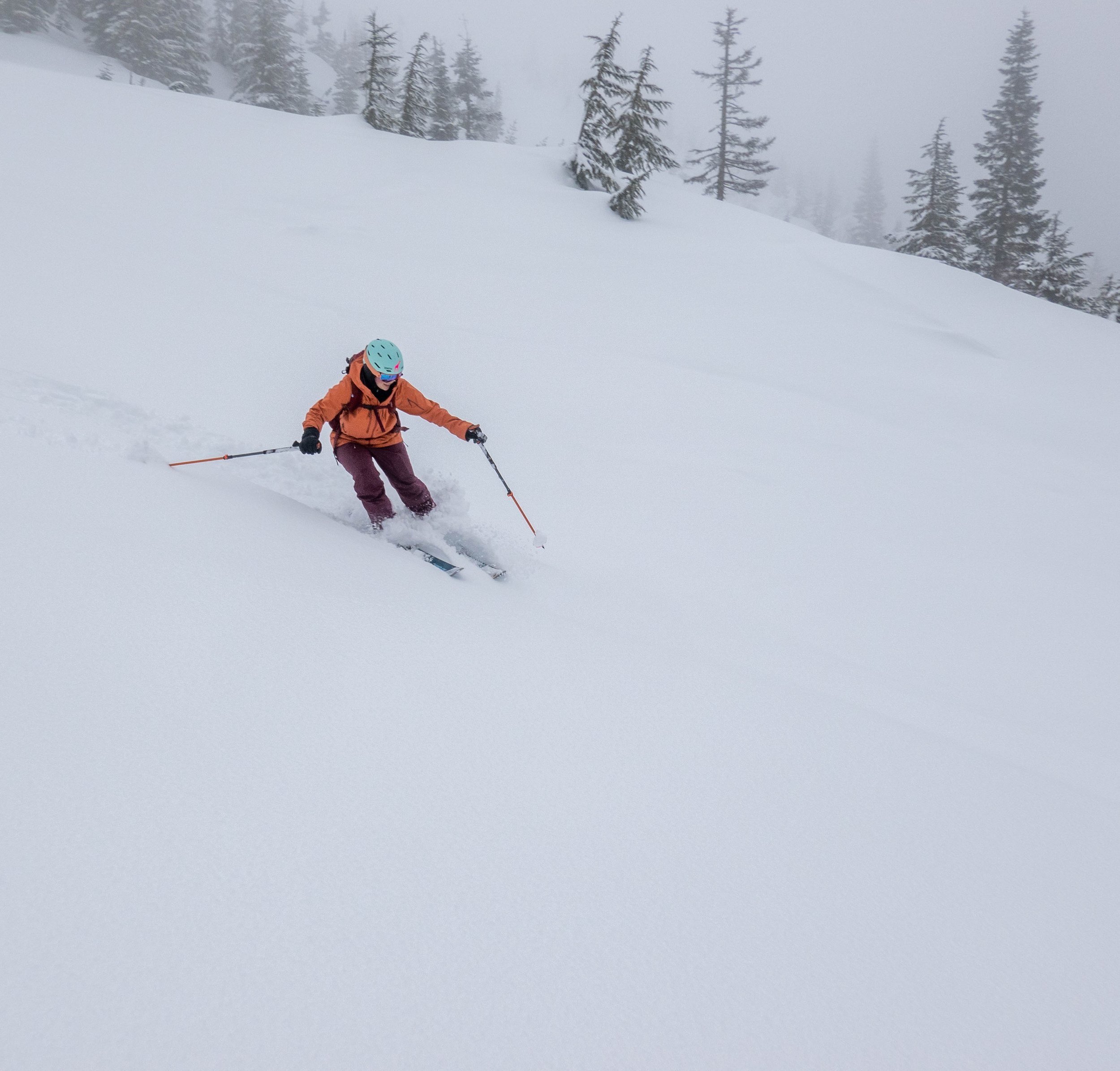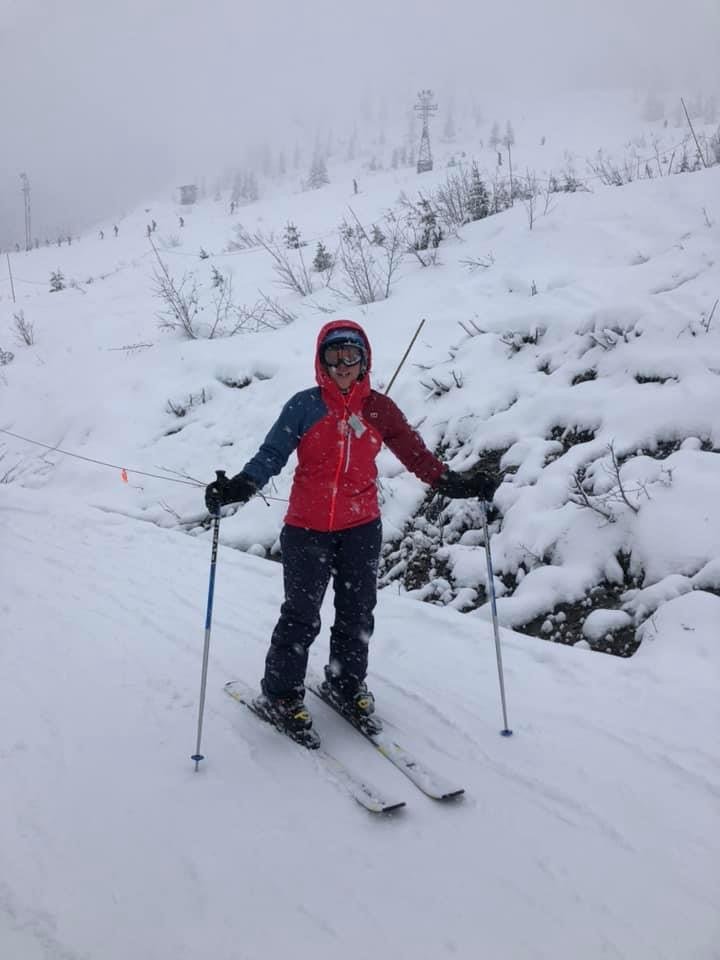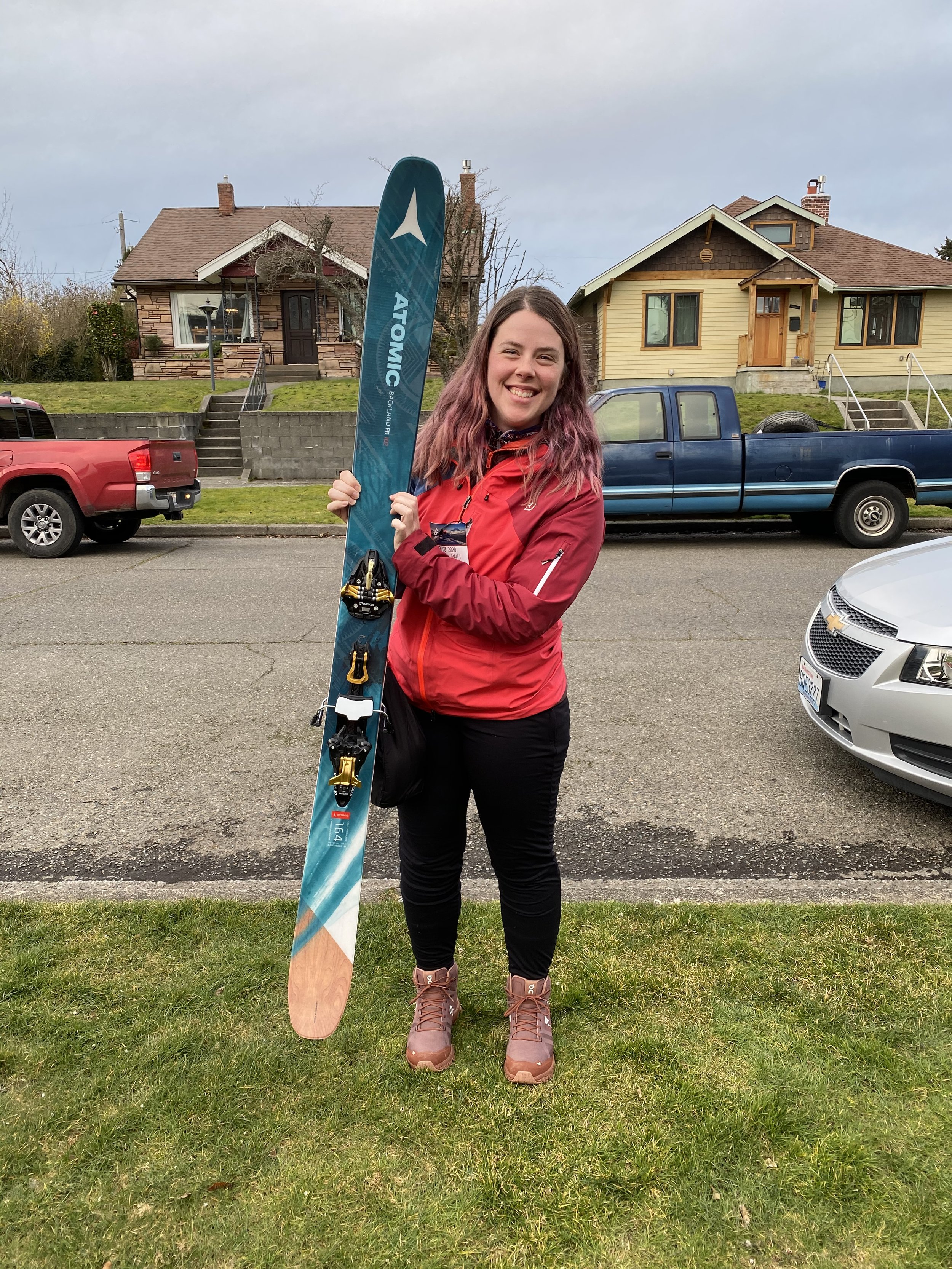How I Learned to Ski as an Adult in Washington
Me on my first backcountry ski tour. Photo by Analisa Price.
I have always lived in the greater Seattle area, despite this, I found myself entering my 30s having never stepped foot in a ski resort. My parents were never very interested in snow sports and though I had friends that skied and snowboarded, I never felt like I had the financial means to try it out. So, I spent most of my winters missing out on the joy that is skiing. What changed you ask? Well, I found myself at the summit of Loowit (Mount Saint Helens for those unfamiliar with the indigenous name) for the second time in 2019. I was bonking hard and watching skiers effortlessly glide down from the summit. I considered the six-mile hike I still had to the car and thought to myself, “I am never climbing this mountain again until I can ski down it” and that winter I signed up for my first ski lesson in an attempt to make that whispered vow a reality.
Learning to ski as an adult is intimidating. We are no longer blessed with rubber joints or feelings of invincibility. I personally looked down the very gentle slope of my first green run and was convinced I would immediately tear an ACL (a fear that has remained with me during the extent of my short skiing career) But it’s also highly rewarding. There is nothing quite as exhilarating as being completely terrified and deciding to try despite that fear. When it goes well, those childhood feelings of invincibility momentarily return. So yes, learning to ski is intimidating, but it doesn’t have to be awful! I was super lucky to have multiple mentors who helped me figure out the best way to get started and I am stoked to share that progression with you now!
Look for ski pass deals targeted towards beginners.
The winter I decided to learn how to ski, I had recently been laid off, so while I had an abundance of free time I was definitely lacking in discretionary income. Amber Chang directed me towards a deal Summit at Snoqualmie offered for beginners. Essentially, I got three group lessons, rentals for the season, and a season pass for the grand total of $550. It’s not a laughable sum but considering Ikon and Epic passes start around $800 and you have to supply your own equipment, it’s definitely a more budget-friendly way to break into the sport. Starting the season with three group lessons also helped me avoid a lot of frustration trying to learn skills on my own. They haven’t offered this deal during the pandemic but I am hoping they will bring it back at a later date!
My first time getting off the big kid lift at Snoqualmie Pass! Photo by Doris Wang
Go as often as you can and push your comfort zone.
Like most things, you will never get better at skiing if you don’t practice often. I went almost every weekend and multiple weekdays my first season before COVID shut resorts down. It’s the only reason I have been able to progress as quickly as I have. Since I started with a goal to break into backcountry skiing, I forced myself to ski in all different types of snow conditions since I wouldn’t be finding perfectly groomed snow outside of the resort. Ice, powder, moguls—I skied it all, and yes, I fell a lot. Pushing myself outside of my comfort zone helped me breakthrough fears that were holding me back. I still have a long way to go but in my third season, I am able to survival ski down black and some double black runs without crying or having a panic attack!
That being said, my goal was to push myself hard and progress as quickly as possible. Go at whatever pace feels best for you! There is no rule saying you have to progress to black diamond terrain if you don’t want to. If you want to cruise groomers and avoid off-piste skiing for the rest of your days, do it! There is space for you on the mountain however you decide to show up.
Find mentors and ski with people better than you.
Find friends who are better skiers than you and ask if they are willing to take you down some easier runs. Follow them down and try to imitate what they are doing. Don’t expect to spend the entire day skiing with them (that would be pretty boring for them) but when they go off to do runs that are too hard for you, practice what you saw them doing on terrain you are comfortable with. When I ski with my more advanced friends, I do my best to turn wherever they turn and keep up with their speed. I am rarely successful, but I find myself getting to the bottom more quickly and gracefully over skiing the same run by myself.
If you don’t already know better skiers, the PNW Outdoor Women group on Facebook is a great resource for this. Post where you generally ski and ask if anyone will be there at the same time and willing to do a few runs with you. Many ski friendships and mentorships have been forged this way, including the majority of my own!
Amber Chang has been an amazing ski mentor and friend to me! Photo by Andrew Holland.
Take private ski lessons or clinics if you can afford them.
As much as I pushed myself outside of my comfort zone and attempted to work on skills with friends, I found myself unable to fix some things I knew were wrong with my form. Regardless of how much I yelled at myself to keep my upper body facing downhill, I would immediately cut across the slope the second I was uncomfortable. I didn’t want to keep drilling in bad habits, so I decided to invest in a private lesson which was extremely helpful! My instructor was able to give drills that helped me break down turns on steeper terrain and find a way to start separating the movement of my upper body from my lower body. It’s still a major work in progress, but I left that lesson feeling like I knew the steps I needed to take in order to fix the issue which was a major improvement from where I started.
Obviously, private lessons are not accessible for everyone. Rippin Chix is a great weekend clinic for women who are hoping to break into steeper runs and off-piste terrain that will set your wallet back less than the same instruction time in a 1:1 setting. Resorts also offer group lessons if you don’t want to wait for a women-specific clinic in your area.
Ready to commit? Purchase used & discounted ski gear.
When I finished my first season, I knew I wanted to invest in this sport for the long haul, but I also knew I couldn’t afford to buy everything brand new. I started looking for a touring setup that I could also use inbounds.
I was directed to the Facebook group PNW Ski Classifieds and within a month of looking, I found a set of 2018 Atomic Backlands with touring bindings and skins for under $500. The same setup would have cost me upwards of $1k if I had purchased it new. If you know you will be in the market for skis soon, I highly recommend stalking that group.
If nothing used comes up there, you can also find good deals on new skis/boots towards the end of the season (after Presidents Day or so). Consignment stores such as Wonderland Gear Exchange have great deals on used ski gear.
Not sure what skis you need? I highly recommend checking out Analisa Price’s website. She is a gift to the PNW Women’s ski community, and her recommendations have never let me down!
Me after I bought my first pair of new-to-me skis! Photo by Doris Wang.
Ignore the haters.
It’s no secret that snow sports can be intentionally exclusionary and toxic. First, you need to have the financial means to afford the gear and access to the mountain. Then, once you are finally there, you might find that some people look down on you for being a beginner. I personally didn’t notice how toxic skiing could be until I started posting videos of my funny ski fails on TikTok. I was suddenly inundated with comments from mostly men either mansplaining skiing to me, making fun of my gear, or telling me I was “ruining” the mountain. The toxic people are out there and you may encounter them whether it’s on the slopes or social media. My advice? Find your people and ignore them. They are a loud group, but they don’t speak for everyone. There are more than enough supportive people who will be stoked to support your progress to go around! Here are a few organizations and groups that focus on making snowsports more inclusive to get you started in your journey, some of these even offer scholarships to help excluded groups hit the slopes:
Hopefully, this is helpful for your beginner ski journey! Huge thanks go out to Amber Chang, Analisa Price, Angela Crampton, Meghan Young, and the many other frientors I have met along the way. I am unsure I ever would have become as addicted to this sport without the support of these amazing women!




